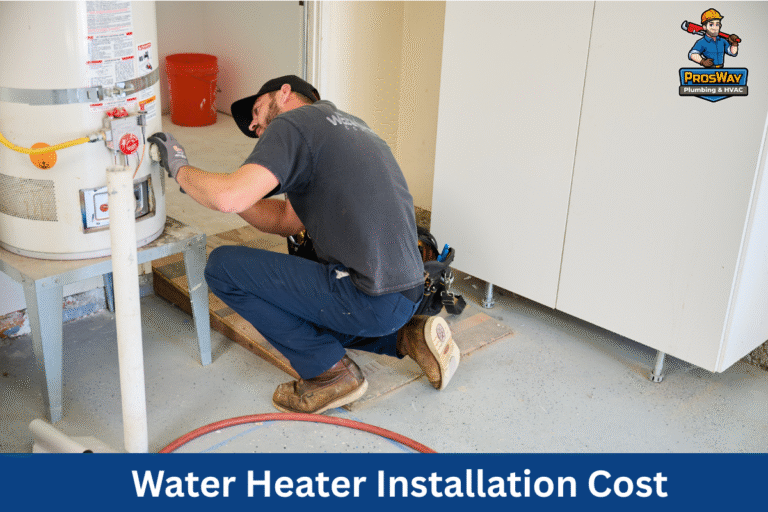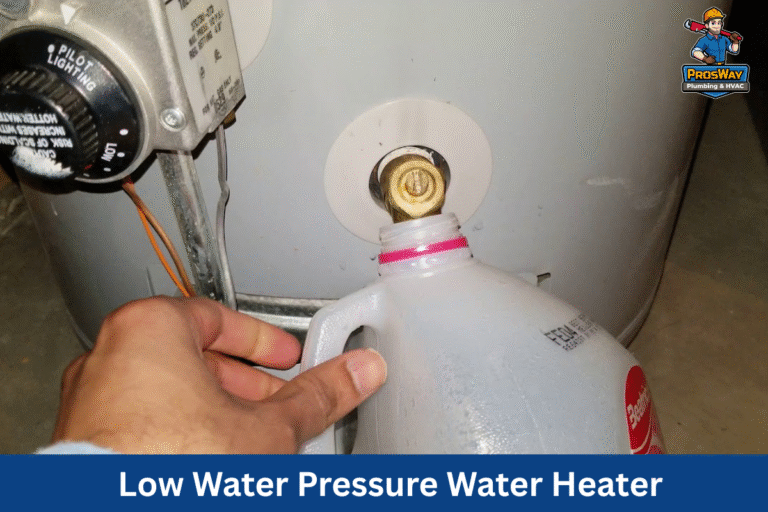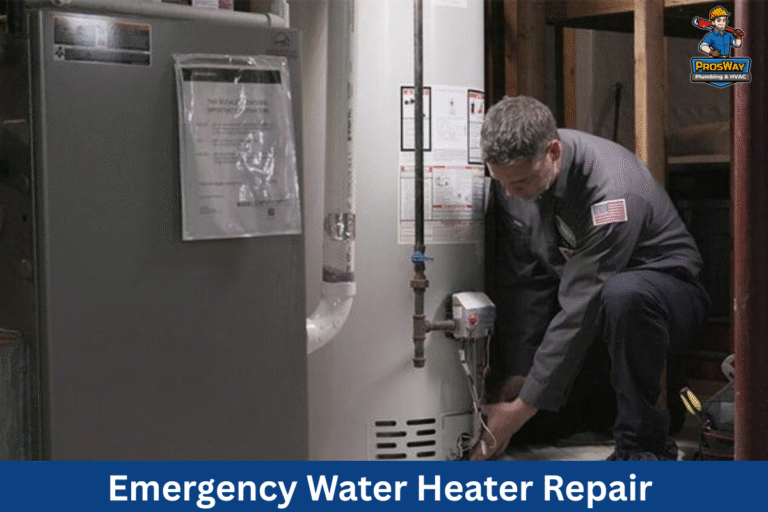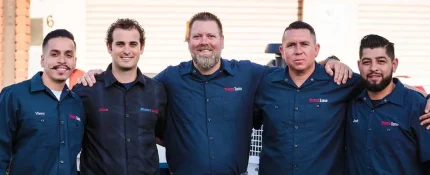A gas water heater is one of the most common ways households get reliable hot water. It works by heating water in a tank using natural gas supplied through gas lines, valves, and fittings. While dependable, these heaters can sometimes develop leaks. A gas water heater leaking doesn’t just affect your hot water supply. It can create safety hazards, damage your home, and increase repair costs if ignored.
This guide explains the signs, causes, and repair steps for a gas water heater leaking water or gas. We’ll also cover when to call a plumber, how to prevent future problems, and why regular inspections matter.
Signs Your Gas Water Heater Is Leaking
A leaking gas hot water heater isn’t always obvious at first. Some signs are subtle, while others demand urgent attention. Watch for:
- Water pooling around the unit; puddles or damp floors near the tank.
- Dripping water from pipes, valves, or fittings, especially around the drain valve or temperature and pressure relief valve (T&P valve).
- Rust, corrosion, or damp spots near the base; a sign of internal tank damage.
- Low water pressure or fluctuating hot water; possible leak, reducing flow.
- Unusual sounds: dripping, hissing, or popping noises. Hissing may indicate a gas leak.
- Rotten eggs odor; a dangerous sign of a natural gas leak caused by loose gas line fittings or a faulty gas valve knob.
Act immediately if you notice both water leaks and gas leak indicators. Shut off the gas supply, open windows and doors, and avoid open flames until a professional arrives.
Common Causes of Gas Water Heater Leaks
Leaks can stem from different parts of the system. So, an awareness of the root cause is the first step in repair.
Loose or Faulty Connections
Loose or faulty connections are one of the simplest but most frequent causes. Over time, the inlet and outlet water supply fittings may loosen due to constant thermal expansion and contraction.
The same is true for flexible gas lines and pipe joints, where vibration and poor sealing allow water, or worse, gas, to escape. If you notice damp fittings or the faint odor of gas, the fittings or seals should be inspected immediately.
Faulty Drain Valve
A faulty drain valve is another culprit. Located at the bottom of the tank, this valve is used during maintenance to flush out sediment. Small puddles can appear at the base of the heater if it becomes worn, cracked, or simply left partially open.
Even though this might seem minor, it indicates the valve is no longer reliable and should be replaced before it fails completely.
Temperature & Pressure Relief (T&P) Valve Issues
The temperature and pressure relief (T&P) valve plays a vital safety role, releasing excess heat or water pressure to prevent the tank from bursting. If the valve is faulty, improperly installed, or clogged with mineral buildup, it can leak continuously.
Sometimes the leak isn’t from the valve itself but from system conditions, such as water pressure that’s too high or water temperatures set above recommended limits. This forces the valve to release water more frequently.
Tank Corrosion & Sediment Build-Up
Tank corrosion and sediment buildup represent more serious long-term problems. Hard water deposits minerals inside the tank, which build up and cause overheating. This stresses the metal and accelerates rust, eventually creating cracks or pinhole leaks in the tank lining.
Once the tank itself is leaking, repairs are rarely possible, and replacement is usually the only solution.
Condensation vs. Actual Leak
Condensation can mimic a water leak. When cold water flows into the tank while it’s heating, moisture may form on the tank’s exterior, especially in humid areas like basements.
Unlike a real leak, condensation dries up once the tank reaches operating temperature. A quick test, wiping the tank dry and monitoring it, can help distinguish between harmless condensation and an actual leak.
How to Repair a Gas Water Heater Leak?

Safety First
Before attempting any inspection:
- Turn off the gas supply using the control gas valve or gas valve knob.
- Turn off the cold-water supply valve to stop incoming water.
- If the unit has electronic ignition, disconnect power.
- Open windows and doors for ventilation if you suspect gas.
- Wear gloves and safety glasses when handling valves or fittings.
- Never use open flames near the heater.
Step-by-Step Checks
Once safe, you can do a quick assessment:
- Inspect connections and fittings for drips or corrosion.
- Check the drain valve for leaks at the base.
- Inspect the T&P valve on the side/top of the tank.
- Look for cracks or rust at the tank base.
- Rule out condensation by drying the tank and rechecking later.
DIY Fixes
You can try certain do-it-yourself fixes if you’re confident with basic tools and safety measures. Always remember: safety first. Shut off the gas supply using the control gas valve or gas valve knob, close the cold-water inlet, and wear gloves and safety glasses before starting.
Tightening Loose Connections
- Use an adjustable wrench to snug up loose water supply fittings.
- Check both hot and cold inlet/outlet connections, as well as the flexible gas line fittings.
- Avoid overtightening; this can crack fittings or strip threads.
Replacing a Faulty Drain Valve Washer
- Attach a hose to the drain valve and drain a few gallons to relieve pressure.
- Use a wrench to remove the valve cap and replace the worn rubber washer.
- Reinstall securely and test for drips.
Addressing a Dripping T&P Valve
- First, test the valve by lifting its lever slightly, then let it snap back. This flushes debris and mineral buildup.
- Replace it with a new valve of the same rating if it still drips.
- Always ensure water pressure and water temperature are within safe ranges before reinstallation.
Dealing with Minor Tank Condensation
- Wipe down the tank and monitor.
- If moisture returns without visible drips from valves, it’s likely condensation.
- Lower the water temperature setting slightly and improve ventilation by opening nearby windows or doors.
Flushing Sediment from the Tank
- Connect a garden hose to the drain valve.
- Open the valve and flush several gallons until the water runs clear of sediment or mineral buildup.
- Close the valve and restore water supply slowly to avoid pressure surges.
When to Call a Professional Plumber
Not every leak can be fixed with a wrench or washer. Some issues point to deeper problems that demand expert help.
- Leaks from the tank itself: If water seeps directly through the tank wall, the system has reached the end of its life. Replacement is the only safe option.
- Persistent T&P valve discharge: A valve that won’t stop releasing water may signal dangerously high tank pressure or temperature. Only a licensed plumber can diagnose and correct this.
- Gas odors or hissing sounds: When you detect a rotten egg smell or hear gas escaping from the flexible gas line or fittings, evacuate and call your gas company immediately. A plumber can inspect connections afterward.
- Leaks that return after quick fixes: If tightening connections or swapping washers doesn’t solve the problem, corrosion or hidden damage may be present.
A professional plumber both repairs the leak and checks for gas line safety, valve function, and code compliance, things DIY fixes can’t guarantee.
Preventing Future Gas Water Heater Leaks

A leaking water heater doesn’t always mean failure is around the corner. With regular care, you can extend its lifespan and reduce risks.
- Schedule annual professional service: A plumber will inspect connections, fittings, and gas lines for wear and tighten them safely.
- Flush the tank yearly: This removes sediment and mineral buildup that cause overheating, corrosion, and cracks. Homes with hard water may need this twice a year.
- Check and replace the anode rod: This sacrificial rod protects the steel tank from rust. If neglected, corrosion eats away at the tank lining instead.
- Test the T&P valve: Lift the lever briefly once a year to ensure it releases water and reseals properly. A stuck valve can create dangerous pressure inside the tank.
- Monitor water pressure: Excessive inlet water pressure stresses valves and tanks. Installing a regulator keeps levels safe (50–60 PSI is ideal).
- Install a drip pan and drain line: When the heater is located indoors or above finished floors, a drip pan offers extra protection against water damage.
Conclusion
A gas water heater leaking isn’t something to ignore. While some issues, like loose fittings, are minor, others, such as tank corrosion or gas leaks, pose serious risks. Acting quickly and scheduling regular maintenance are the best ways to protect your home and stay safe.
Need Help with a Leaking Gas Water Heater?
Don’t let a small drip turn into costly repairs or a safety hazard. If you’re in Northern New Jersey, the licensed technicians at ProsWay Plumbing & HVAC are ready to help. From quick fixes to full water heater installations, they keep your water heater running safely and reliably. Call us today for expert water heater service and peace of mind.









